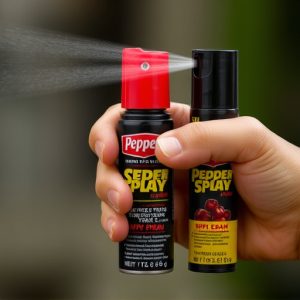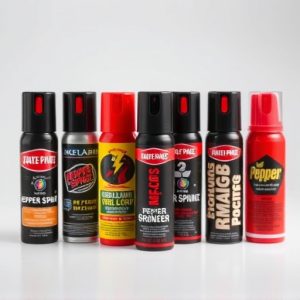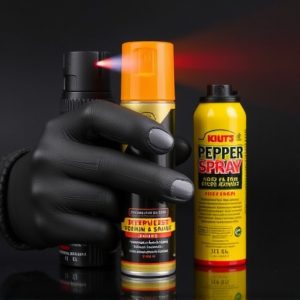Decoding Pepper Spray Pricing: A Manufacturer’s Perspective
Pepper spray pricing is influenced by a variety of factors including production costs, quality of i…….
Pepper spray pricing is influenced by a variety of factors including production costs, quality of ingredients, design and engineering of delivery systems, brand reputation, market positioning, customer service levels, R&D investment, compliance costs, economies of scale, and technological advancements. Manufacturers face diverse expenses from sourcing materials to maintaining safety standards, which contribute to the overall cost. High-quality manufacturers with advanced technology and strict testing often set higher prices due to their standing in the industry. Larger producers can leverage economies of scale for more competitive rates by reducing per unit costs through efficient production. The market for pepper spray is dynamic, shaped by consumer demand, supply chain efficiencies, raw material costs, regulatory compliance, and technological innovations like gel-based and foam products. When choosing a pepper spray, consumers should consider product quality, safety certifications, customer feedback, and value for money, balancing these factors to find a reliable product that meets their personal protection needs without overspending.
Navigating the market for pepper spray reveals a dynamic interplay of factors that shape its pricing. This article delves into the cost influences and production considerations that pepper spray manufacturers face, offering insights through a comparative lens of leading brands. We explore market trends and demand dynamics, providing strategies for consumers to procure quality pepper spray at competitive prices. Join us as we examine the economics behind pepper spray pricing and offer guidance on making informed purchasing decisions.
Understanding the Factors Influencing Pepper Spray Pricing from Manufacturers
When examining the factors that influence the pricing of pepper spray by manufacturers, it’s crucial to consider the production costs and materials used in each unit. The quality of the peppers, such as capsaicin concentration, can significantly affect the price due to the labor-intensive process required for extraction and formulation. Additionally, the design and engineering behind the pepper spray delivery systems vary, with some manufacturers investing in advanced technologies that allow for greater accuracy or non-lethal effects, which can command higher prices.
Manufacturing costs, including research and development, also play a role in determining the final price of pepper spray. This includes the expenses related to sourcing high-quality raw materials, adhering to stringent safety standards, and undergoing rigorous testing to ensure compliance with legal requirements. Furthermore, brand reputation, market positioning, and the level of customer service provided by the manufacturer can also influence pricing strategies. Companies that are recognized for their reliability and quality may price their pepper spray higher than competitors due to their established reputation in the industry. Additionally, economies of scale come into play; larger manufacturers with extensive production facilities might offer competitive pricing due to their ability to produce at a lower cost per unit. These factors collectively contribute to the range of prices that pepper spray products command in the market.
The Role of Production Costs in Determining Pepper Spray Prices by Manufacturers
The retail cost of pepper spray, as it reaches consumers, is influenced by a myriad of factors, with production costs standing out among them. Pepper spray manufacturers incur various expenses during the production process, which are integral to the final price point. These costs encompass raw materials for the spray’s formulation, the design and manufacturing of the canister, compliance-related certifications, and quality assurance processes. The sophistication of the spray’s mechanism, durability of the canister, and the precision of its dosing system all contribute to the production expenses. Moreover, the costs associated with research and development to enhance product efficacy and safety also play a role in shaping the prices. Manufacturers that invest in advanced technology and rigorous testing to ensure their pepper spray meets high standards are likely to reflect these investments in their pricing strategy, which in turn affects the cost for end-users.
Furthermore, the competitive landscape within the pepper spray market can influence pricing as well. Even though multiple manufacturers produce pepper spray, those that differentiate their products through unique features or superior quality may command higher prices. Economies of scale and production efficiency also come into play; manufacturers with larger production volumes often have the advantage of reduced costs per unit, which can translate to more competitive pricing for consumers. It’s important to consider how these production elements interact with market dynamics, regulatory requirements, and distribution channels to ultimately determine the price of pepper spray on store shelves.
Comparative Analysis of Pepper Spray Pricing Across Leading Manufacturers
Market Trends and Demand Dynamics Shaping the Price of Pepper Spray from Manufacturers
The price landscape for pepper spray has been influenced by a confluence of factors, with market trends and demand dynamics playing pivotal roles in shaping how manufacturers set their prices. Recent years have seen an uptick in consumer interest for personal safety devices, with pepper spray being one of the most sought-after non-lethal self-defense tools. This increased demand has been driven by rising crime rates in certain regions and heightened awareness about personal security. As a result, pepper spray manufacturers have had to adapt their production strategies to meet the growing market needs. The availability of raw materials and the costs associated with them are significant factors affecting pricing. Fluctuations in the cost of capsaicin, the active ingredient in pepper spray, can lead to significant changes in the price points of these products. Additionally, regulatory changes, such as stricter safety standards or licensing requirements, can also influence manufacturing costs and subsequently the retail prices.
Supply chain considerations are equally important. Efficient supply chains enable manufacturers to produce pepper spray at a lower cost, which can be passed on to consumers. However, disruptions like those caused by the COVID-19 pandemic have highlighted the vulnerabilities in global supply chains, leading to shortages and price volatility. To mitigate these risks, some manufacturers are increasingly localizing their production or diversifying their supplier base. Furthermore, technological advancements in pepper spray manufacturing processes, such as the introduction of gel-based or foam formulations, have led to product innovation that can command higher prices. These factors combined create a dynamic market where the price of pepper spray is subject to both internal and external influences, making it a complex pricing environment for manufacturers.
Strategies for Procurement: Balancing Cost and Quality with Pepper Spray Manufacturers
When considering the procurement of pepper spray, a balance between cost and quality is paramount for both personal safety and budget management. Pepper spray manufacturers offer a range of products with varying efficacies, capacities, and formulations. To ensure the acquisition of high-quality pepper spray that aligns with your budgetary constraints, it’s essential to conduct thorough market research. This includes evaluating different manufacturers based on their reputation, the certifications of their products, and customer reviews. A strategic approach involves comparing the price points against the features offered; for instance, consider the spray range, the concentration of the active ingredient, and the reliability under various environmental conditions. Additionally, purchasing in bulk from reputable pepper spray manufacturers can often yield cost savings while maintaining a high standard of quality. It’s also advisable to consider the manufacturer’s track record in terms of compliance with safety standards and regulations, as this can be a strong indicator of the product’s performance and your overall protection. By carefully assessing these factors, you can effectively navigate the market and procure pepper spray that offers both value for money and the confidence of knowing you are equipped with a trusted personal defense tool.


